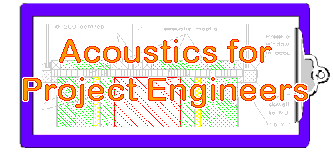

Part 2: Ventilation
Why begin with the ventilation?
It may seem strange to start the detailed discussion on studio specification, with the ventilation system. However, once the basic size and layout of the studios is fixed, the designed level of ventilation noise can be one of the most important factors that affects the construction and cost of the building work.
It's a good idea to think about ventilation very early. Getting cool air quietly into a studio can be far from easy. The ventilation can even be the deciding factor for whether you can put the studio where you want it at all! This is especially true when putting a studio into an existing building. The mechanical services engineer should be involved at the earliest possible stage. A studio is a sealed well insulated box, often with lots of expensive heaters (microchips) inside, and will always need cooling.
Please fix the ventilation - it's too quiet
But from a purely acoustic point of view, the reason it is important, is that interfering sound from outside will be a nuisance only if its level is higher than the sound level of the studio ventilation (this is called "masking"). So the louder the ventilation noise, the less isolation is needed from external noise. Ventilation noise should not be specified too quiet!
Low frequency "rumbly" ventilation noise won't mask high frequency interfering sound, and high frequency "hissy" ventilation won't mask interfering low frequency sound. In fact noise masking works well only within a fairly small frequency range. So we need to know the spectrum, not just the A-weighted level in decibels. Also the ventilation noise itself should not be rumbly or hissy - it should be a neutral sound.
There are several ways of specifying levels of ventilation noise, that are designed to achieve a fairly neutral sound. The most common in the UK are the NC (noise criterion) and NR (noise rating). Both these methods specify the maximum permitted noise level in octave bands. Some NR criteria are shown as an example. (NC curves are slightly different, but the difference between say NR30 and NC30 is quite subtle.)

Some typical specifications are:
| Type of room | Vent. noise spec |
| Office | NR35 |
| Studio, news insert, single mic | NR25 |
| Studio, general speech & DJ | NR20 |
| Studio, high quality broadcast | NR15 |
Some studios will need even lower noise levels than NC15. But because of the knock-on effect on required isolation, decisions on low levels of ventilation noise should not be taken lightly.
The human ear is very sensitive to "tonal" noise, that is, a noise in which you can identify a particular pitch. It is also more sensitive to a varying noise than it is to a steady noise, especially if the variation has a repeating rhythm. (That's why car alarms are so annoying - they're optimised to be as noticeable as possible!) A tonal noise that's quite audible might not show up in a simple measurement, and a noise that varies in level certainly won't show up in the usual type of measurement. So it is common to have clauses in mechanical services specifications, to outlaw these types of noise. Continue
Phone or email for a free initial discussion about your project.
Phone 020 7624 2512 or click
to contact
us.
Text charts and images copyright Tony Woolf 2000 & 2007 unless otherwise stated.




